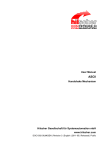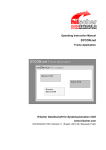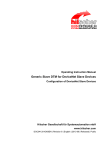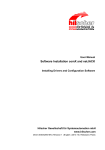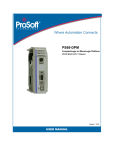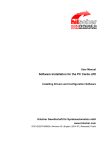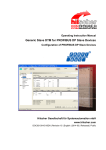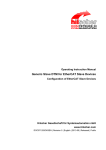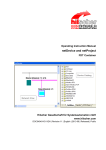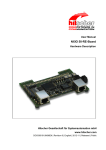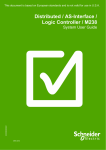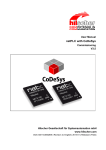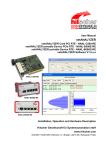Download Generic Slave DTM for AS-Interface Slave Devices
Transcript
Operating Instruction Manual Generic Slave DTM for AS-Interface Slave Devices Configuration of AS-Interface Slave Devices Hilscher Gesellschaft für Systemautomation mbH www.hilscher.com DOC090604OI05EN | Revision 5 | English | 2013-09 | Released | Public Table of Contents 2/41 Table of Contents 1 INTRODUCTION.........................................................................................................4 1.1 About this Manual .......................................................................................................4 1.1.1 1.1.2 1.1.3 1.2 Legal Notes.................................................................................................................6 1.2.1 1.2.2 1.2.3 1.2.4 1.2.5 1.2.6 1.3 Configuration Steps ..................................................................................................16 CONFIGURATION ....................................................................................................17 3.1 Overview Configuration ............................................................................................17 3.2 Configuring Slave Parameters..................................................................................18 3.3 General .....................................................................................................................19 3.4 Configuration ............................................................................................................20 3.4.1 3.4.2 3.5 4 5 Configuring Slave Data ......................................................................................21 Configuring Parameter Data...............................................................................22 Signal Configuration .................................................................................................23 DEVICE DESCRIPTION ...........................................................................................24 4.1 About Device Description .........................................................................................24 4.2 Device Info................................................................................................................24 ONLINE FUNCTIONS ...............................................................................................25 5.1 6 General Device Information................................................................................12 Navigation Area ..................................................................................................12 Dialog Panes ......................................................................................................13 OK, Cancel, Apply and Help...............................................................................14 Status Bar...........................................................................................................15 GETTING STARTED.................................................................................................16 2.1 3 Requirements .......................................................................................................9 AS-Interface Slave Profiles ................................................................................10 Dialog Structure of the Generic AS-Interface Slave DTM.........................................11 1.4.1 1.4.2 1.4.3 1.4.4 1.4.5 2 Copyright ..............................................................................................................6 Important Notes ....................................................................................................6 Exclusion of Liability .............................................................................................7 Warranty ...............................................................................................................7 Export Regulations ...............................................................................................8 Registered Trademarks........................................................................................8 About Generic AS-Interface Slave DTM .....................................................................9 1.3.1 1.3.2 1.4 Online Help...........................................................................................................4 List of Revisions ...................................................................................................4 Conventions in this Manual ..................................................................................5 Connecting/Disconnecting Device ............................................................................25 DIAGNOSIS ..............................................................................................................26 Generic Slave DTM for AS-Interface Slave Devices | Configuration of AS-Interface Slave Devices DOC090604OI05EN | Revision 5 | English | 2013-09 | Released | Public © Hilscher, 2009-2013 Table of Contents 7 3/41 6.1 Overview Diagnosis ..................................................................................................26 6.2 General Diagnosis ....................................................................................................27 APPENDIX ................................................................................................................28 7.1 User Rights ...............................................................................................................28 7.1.1 Configuration ......................................................................................................28 7.2 I/O Code, ID Code, ID2 Code and Slave Profiles .....................................................29 7.3 I/O Data Size depending by IO and ID Code ............................................................31 7.3.1 7.3.2 AS-Interface Slave Types...................................................................................32 Examples for I/O Data Size depending on Slave Profile....................................34 7.4 References ...............................................................................................................38 7.5 List of Figures ...........................................................................................................39 7.6 List of Tables ............................................................................................................39 7.7 Glossary....................................................................................................................40 7.8 Contacts....................................................................................................................41 Generic Slave DTM for AS-Interface Slave Devices | Configuration of AS-Interface Slave Devices DOC090604OI05EN | Revision 5 | English | 2013-09 | Released | Public © Hilscher, 2009-2013 Introduction 1 4/41 Introduction 1.1 About this Manual This manual provides information on how to set up AS-Interface Slave devices described with EDS files. These devices can be configured with the AS-Interface generic Slave DTM within an FDT Framework. Dialog Panes The table below gives an overview for the individual dialog panes descriptions: Section Subsection Manual Page Configuration General 19 Configuration 20 Signal Configuration 23 Device Description Device Info 24 Diagnosis General Diagnosis 27 Table 1 Descriptions Dialog Panes 1.1.1 Online Help The generic AS-Interface Slave DTM contains an integrated online help facility. To open the online help, click on Help or press F1. . 1.1.2 List of Revisions Index Date Version Component Chapter Revision 5 13-08-14 1.0002.x.x 1.0002.x.x AS-iSlaveDTM.dll, AS-iSlaveGUI.ocx All, 1.3.1 Revised, Section Requirements, Windows 8 added. Generic Slave DTM for AS-Interface Slave Devices | Configuration of AS-Interface Slave Devices DOC090604OI05EN | Revision 5 | English | 2013-09 | Released | Public © Hilscher, 2009-2013 Introduction 1.1.3 5/41 Conventions in this Manual Notes, operation instructions and results of operation steps are marked as follows: Notes Important: <important note> Note: <note> <note, where to find further information> Operation Instructions 1. <instruction> 2. <instruction> or <instruction> Results <result> Generic Slave DTM for AS-Interface Slave Devices | Configuration of AS-Interface Slave Devices DOC090604OI05EN | Revision 5 | English | 2013-09 | Released | Public © Hilscher, 2009-2013 Introduction 1.2 1.2.1 6/41 Legal Notes Copyright © Hilscher, 2009-2013, Hilscher Gesellschaft für Systemautomation mbH All rights reserved. The images, photographs and texts in the accompanying material (user manual, accompanying texts, documentation, etc.) are protected by German and international copyright law as well as international trade and protection provisions. You are not authorized to duplicate these in whole or in part using technical or mechanical methods (printing, photocopying or other methods), to manipulate or transfer using electronic systems without prior written consent. You are not permitted to make changes to copyright notices, markings, trademarks or ownership declarations. The included diagrams do not take the patent situation into account. The company names and product descriptions included in this document may be trademarks or brands of the respective owners and may be trademarked or patented. Any form of further use requires the explicit consent of the respective rights owner. 1.2.2 Important Notes The user manual, accompanying texts and the documentation were created for the use of the products by qualified experts, however, errors cannot be ruled out. For this reason, no guarantee can be made and neither juristic responsibility for erroneous information nor any liability can be assumed. Descriptions, accompanying texts and documentation included in the user manual do not present a guarantee nor any information about proper use as stipulated in the contract or a warranted feature. It cannot be ruled out that the user manual, the accompanying texts and the documentation do not correspond exactly to the described features, standards or other data of the delivered product. No warranty or guarantee regarding the correctness or accuracy of the information is assumed. We reserve the right to change our products and their specification as well as related user manuals, accompanying texts and documentation at all times and without advance notice, without obligation to report the change. Changes will be included in future manuals and do not constitute any obligations. There is no entitlement to revisions of delivered documents. The manual delivered with the product applies. Hilscher Gesellschaft für Systemautomation mbH is not liable under any circumstances for direct, indirect, incidental or follow-on damage or loss of earnings resulting from the use of the information contained in this publication. Generic Slave DTM for AS-Interface Slave Devices | Configuration of AS-Interface Slave Devices DOC090604OI05EN | Revision 5 | English | 2013-09 | Released | Public © Hilscher, 2009-2013 Introduction 1.2.3 7/41 Exclusion of Liability The software was produced and tested with utmost care by Hilscher Gesellschaft für Systemautomation mbH and is made available as is. No warranty can be assumed for the performance and flawlessness of the software for all usage conditions and cases and for the results produced when utilized by the user. Liability for any damages that may result from the use of the hardware or software or related documents, is limited to cases of intent or grossly negligent violation of significant contractual obligations. Indemnity claims for the violation of significant contractual obligations are limited to damages that are foreseeable and typical for this type of contract. It is strictly prohibited to use the software in the following areas: for military purposes or in weapon systems; for the design, construction, maintenance or operation of nuclear facilities; in air traffic control systems, air traffic or air traffic communication systems; in life support systems; in systems in which failures in the software could lead to personal injury or injuries leading to death. We inform you that the software was not developed for use in dangerous environments requiring fail-proof control mechanisms. Use of the software in such an environment occurs at your own risk. No liability is assumed for damages or losses due to unauthorized use. 1.2.4 Warranty Although the hardware and software was developed with utmost care and tested intensively, Hilscher Gesellschaft für Systemautomation mbH does not guarantee its suitability for any purpose not confirmed in writing. It cannot be guaranteed that the hardware and software will meet your requirements, that the use of the software operates without interruption and that the software is free of errors. No guarantee is made regarding infringements, violations of patents, rights of ownership or the freedom from interference by third parties. No additional guarantees or assurances are made regarding marketability, freedom of defect of title, integration or usability for certain purposes unless they are required in accordance with the law and cannot be limited. Warranty claims are limited to the right to claim rectification. Generic Slave DTM for AS-Interface Slave Devices | Configuration of AS-Interface Slave Devices DOC090604OI05EN | Revision 5 | English | 2013-09 | Released | Public © Hilscher, 2009-2013 Introduction 1.2.5 8/41 Export Regulations The delivered product (including the technical data) is subject to export or import laws as well as the associated regulations of different counters, in particular those of Germany and the USA. The software may not be exported to countries where this is prohibited by the United States Export Administration Act and its additional provisions. You are obligated to comply with the regulations at your personal responsibility. We wish to inform you that you may require permission from state authorities to export, re-export or import the product. 1.2.6 Registered Trademarks Windows® XP, Windows® Vista, Windows® 7 and Windows® 8 are registered trademarks of Microsoft Corporation. All other mentioned trademarks are property of their respective legal owners. Generic Slave DTM for AS-Interface Slave Devices | Configuration of AS-Interface Slave Devices DOC090604OI05EN | Revision 5 | English | 2013-09 | Released | Public © Hilscher, 2009-2013 Introduction 1.3 9/41 About Generic AS-Interface Slave DTM You can use the AS-Interface generic Slave DTM to configure the ASInterface Slave devices described with EDS files within a FDT Framework. The information necessary for the configuration of the AS-Interface Slave devices is stored within the AS-Interface Master device when using the ASInterface generic Slave DTM and thus the Master device is configured. 1.3.1 Requirements System Requirements PC with 1 GHz processor or higher Windows® XP SP3, Windows® Vista (32 bit) SP2, Windows® 7 (32 bit) SP1, Windows® 7 (64 bit) SP1, Windows® 8 (32 bit) or Windows® 8 (64 bit) Administrator privilege required for installation Internet Explorer 5.5 or higher RAM: min. 512 MByte, recommended 1024 MByte Graphic resolution: min. 1024 x 768 pixel Keyboard and Mouse Note: If the project file is saved and opened again or if it is used on another PC, the system requirements must match. Particularly the DTM must be installed on the used PC. Restriction Touch screen is not supported. Requirements AS-Interface Generic Slave DTM Requirements for working with the AS-Interface generic Slave DTM are: Installed FDT/DTM V 1.2 compliant frame application Installed AS-Interface Master DTM EDS file of the devices to be configured The user needs to reload the Device Catalog Loading EDS files To add devices to the netDevice device catalog, you must import the EDS file of the used device via netDevice menu Network > Import Device Descriptions …. into the EDS folder of the DTM. Then the Device Cataloge must be reloaded. The folder EDS inclusively Windows® XP is located in the application data directory (All Users) of the configuration software (or from with Windows® 7 on in the C:\ProgramData\ SYCONnet directory). For further information refer to section Configuration Steps on page 16 , under step 1 and 2. Generic Slave DTM for AS-Interface Slave Devices | Configuration of AS-Interface Slave Devices DOC090604OI05EN | Revision 5 | English | 2013-09 | Released | Public © Hilscher, 2009-2013 Introduction 1.3.2 10/41 AS-Interface Slave Profiles Each EDS file corresponds to a Slave profile (specified by the AS-i Protocol specification). The following table shows the available Slave profiles defined each in an EDS file. Available AS-Interface Slave Profiles: Device Name from the EDS File S-0.0, Remote I/O Port S-7.4, Interface for 16-bit Signals S-0.1, Two Dual-Signal Sensor S-7.5, Combi field device S-0.A, Extended Addressing Mode S-7.A, Extended Addressing Mode S-0.B, Safety Slave S-7.B, Safety Slave S-0.F, No Profile S-7.D, Motor Control Device (electromechanical) S-1.0, Remote I/O Port S-7.E, Motor Control Device (semiconductor) S-1.1, Single Sensor (ext. control.) S-7.F, No Profile S-1.A, Extended Addressing Mode S-8.0, Remote I/O Port S-1.F, No Profile S-8.1, Two Dual-Signals Actuator S-2.0, Remote I/O Port S-8.A, Extended Addressing Mode S-2.F, No Profile S-8.F, No Profile S-3.0, Remote I/O Port S-9.A, Extended Addressing Mode S-3.1, One dual sensor, one dual actuator S-9.F, No Profile S-3.A, Extended Addressing Mode S-A.0, Remote I/O Port S-3.F, No Profile S-A.F, No Profile S-4.0, Remote I/O Port S-B.1, Dual Actuator with Feedback S-4.A, Extended Addressing Mode S-B.A, Extended Addressing Mode S-4.F, No Profile S-B.F, No Profile S-5.0, Remote I/O Port S-C.0, Remote I/O Port S-5.A, Extended Addressing Mode S-C.A, Extended Addressing Mode S-5.F, No Profile S-C.F, No Profile S-6.0, Remote I/O Port S-D.1, Single Actuator with Monitoring S-6.A, Extended Addressing Mode S-D.A, Extended Addressing Mode S-6.F, No Profile S-D.F, No Profile S-7.0, Remote I/O Port S-E.0, Remote I/O Port S-7.1, Interface for 6-18-bit Signals S-E.A, Extended Addressing Mode S-7.2, Interface for 6-21-bit Signals S-E.F, No Profile S-7.3, Interface for 16-bit Signals Table 2: Available AS Interface Slave Profiles The Slave profile notation for the example profile 7.A.8 is: I/O Configuration code = 7 ID Code = A Ext. ID2 code = 8 For further information to the Slave profiles refer to section I/O Code, ID Code, ID2 Code and Slave Profiles on page 29, I/O Data Size depending by IO and ID Code on page 31 and to [3]. Generic Slave DTM for AS-Interface Slave Devices | Configuration of AS-Interface Slave Devices DOC090604OI05EN | Revision 5 | English | 2013-09 | Released | Public © Hilscher, 2009-2013 Introduction 1.4 11/41 Dialog Structure of the Generic AS-Interface Slave DTM The graphical user interface of the DTM is composed of different areas and elements listed hereafter: 1. A header area containing the General Device Information, 2. The Navigation Area (area on the left side), 3. The Dialog Pane (main area on the right side), 4. OK, Cancel, Apply, Help, 5. The Status Line containing information e. g. the online-state of the DTM. Figure 1: Dialog Structure of the Generic AS-Interface Slave DTM Generic Slave DTM for AS-Interface Slave Devices | Configuration of AS-Interface Slave Devices DOC090604OI05EN | Revision 5 | English | 2013-09 | Released | Public © Hilscher, 2009-2013 Introduction 1.4.1 12/41 General Device Information Parameter Meaning IO Device Name of the device Vendor Vendor name of the device Device ID Identification number of the device Vendor ID Identification number of the vendor Table 3: General Device Information 1.4.2 Navigation Area The Navigation Area contains folders and subfolders to open the dialog panes of the DTM. Navigation Area Configuration General Configuration Signal Configuration Device Description Device Info Figure 2: Navigation Area Select the required folder and subfolder. The corresponding Dialog pane is displayed. Hide / display Navigation Hiding the navigation area (above right side). Opening the navigation area (below left side). Generic Slave DTM for AS-Interface Slave Devices | Configuration of AS-Interface Slave Devices DOC090604OI05EN | Revision 5 | English | 2013-09 | Released | Public © Hilscher, 2009-2013 Introduction 1.4.3 13/41 Dialog Panes At the dialog pane the Settings, Device Description or Diagnosis (depending by Slave) panes are opened via the corresponding folder in the navigation area. Configuration General At the pane General the symbolic name of the generic AS-Interface Slave device station can be set. Further information to this you find in section General on page 19. Configuration At the pane Configuration the slave data and the parameter data of the generic AS-Interface Slave device station can be set. Further information to this you find in section Configuration on page 20 Signal Configuration At the pane Signal Configuration for the single signals respectively the names of the tags are set or the data types configured. Further information to this you find in section Signal Configuration on page 23 Device Description Device The Device Info pane contains the manufacturer information about the device. Further information to this you find in section Device Info on page 24. Diagnosis Diagnosis (depending by Slave) At the Diagnosis panes diagnosis information can be read. For further information, refer to section Overview Diagnosis on page 26. Table 4: Overview Dialog Panes Note: To get access to the Diagnosis panes of the Generic AS-Interface Slave DTM requires an online connection from the AS-Interface Slave DTM to the AS-Interface Master DTM. For further information, refer to section Connecting/Disconnecting Device on page 25. Generic Slave DTM for AS-Interface Slave Devices | Configuration of AS-Interface Slave Devices DOC090604OI05EN | Revision 5 | English | 2013-09 | Released | Public © Hilscher, 2009-2013 Introduction 1.4.4 14/41 OK, Cancel, Apply and Help OK, Cancel, Apply and Help you can use as described hereafter. Meaning OK To confirm your latest settings, click OK. All changed values will be applied on the frame application database. The dialog then closes. Cancel To cancel your latest changes, click Cancel. Answer to the safety query Configuration data has been changed. Do you want to save the data? by Yes, No or Cancel. Yes: The changes are saved or the changed values are applied on the frame application database. The dialog then closes. No: The changes are not saved or the changed values are not applied on the frame application database. The dialog then closes. Cancel: Back to the DTM. Apply To confirm your latest settings, click Apply. All changed values will be applied on the frame application database. The dialog remains opened. Help To open the DTM online help, click Help. Table 5: OK, Cancel, Apply and Help Generic Slave DTM for AS-Interface Slave Devices | Configuration of AS-Interface Slave Devices DOC090604OI05EN | Revision 5 | English | 2013-09 | Released | Public © Hilscher, 2009-2013 Introduction 1.4.5 15/41 Status Bar The Status Bar displays information about the current state of the DTM. The current activity, e.g. the DTM connection state, is signaled graphically via icons in the status bar. Figure 3: Status Bar – Status Fields 1 to 6 Status Field Icon / Meaning 1 DTM Connection States Connected: Icon closed = Device is online Disconnected: Icon opened = Device is offline 2 Data Source States Data set: The displayed data are read out from the instance data set (database). Device: The displayed data are read out from the device. 3 States of the instance Date Set Valid Modified: Parameter is changed (not equal to data source). Table 6: Status Bar Icons [1] Offline State Online State Figure 4: Status Bar Display Example Generic Slave DTM for AS-Interface Slave Devices | Configuration of AS-Interface Slave Devices DOC090604OI05EN | Revision 5 | English | 2013-09 | Released | Public © Hilscher, 2009-2013 Getting started 2 2.1 16/41 Getting started Configuration Steps The following overview describes the steps to configure a AS-Interface Slave device with the AS-Interface generic Slave DTM as it is typical for many cases. At this time it is presupposed that the AS-Interface Master DTM installation was already done. The overview lists all the steps in a compressed form. For detailed descriptions of each step refer to the sections noted in the column For detailed information see section. For detailed information see section # Step Short Description 1 Add ASInterface Slave in the Device Catalog Add the Slave in the Device Catalog by importing the device description file to the Device Catalog. Depending of the FDT Container. For netDevice: - Network > Import Device Descriptions. Load device catalog Depending of the FDT Container. For netDevice: - select Network > Device Catalog, - select button Reload Catalog. Create new project / Open existing project Depending of the frame application. For the configuration software: - select File > New or File > Open. 4 Insert Master or Slave into configuration Depending of the FDT Container. For netDevice: - in the Device Catalog click to the Master, - and insert the device via drag and drop to the line in the network view, - in the Device Catalog click to the Slave, - and insert the device via drag and drop to the Master bus line in the network view. - - 5 Configure Slave Configure the Slave device. - Double click to the device icon of the Slave. - The Slave DTM configuration dialog is displayed. In the Slave DTM configuration dialog: - select Configuration > General, - set the symbolic name of the generic AS-Interface Slave device station, - select Configuration > Configuration, - set the Slave data and the parameter data, - select Configuration > Signal Configuration, - set for the single signals the names of the tags or the data types, - close the Slave DTM configuration dialog via the button OK. Configuring Slave Parameter 18 General 19 Configuration 20 Signal Configuration 23 (See Operating Instruction Manual DTM for AS-Interface Master devices) - 2 3 6 Configuration Steps Master device Configure the Master device via AS-Interface Master DTM. 7 Save project Depending of the frame application. For the configuration software: - select File > Save. Page - (See Operating Instruction Manual netDevice and netProject) (See Operating Instruction Manual netDevice and netProject) (See Operating Instruction Manual of the Frame Application) (See Operating Instruction Manual of the Frame Application) Table 7: Getting started - Configuration Steps For information to further steps as Diagnosis, refer to the user manual DTM for AS-Interface Master devices. Generic Slave DTM for AS-Interface Slave Devices | Configuration of AS-Interface Slave Devices DOC090604OI05EN | Revision 5 | English | 2013-09 | Released | Public © Hilscher, 2009-2013 Configuration 3 3.1 17/41 Configuration Overview Configuration Dialog Panes “Configuration” The table below gives an overview about the available Configuration dialog panes descriptions: Generic AS-Interface Slave DTM Navigation Area Configuration General 19 Configuration 20 Signal Configuration 23 General Configuration Signal Configuration Table 8: Descriptions of the Dialog Panes Dialog Panes Configuration Notice the descriptions in the section Configuration Steps on page 16. Note: Access to the configuration panes is enabled without requirement of user rights. However for editing certain user rights are required. Further information can be found in section and User Rights on page 28. Generic Slave DTM for AS-Interface Slave Devices | Configuration of AS-Interface Slave Devices DOC090604OI05EN | Revision 5 | English | 2013-09 | Released | Public © Hilscher, 2009-2013 Configuration 3.2 18/41 Configuring Slave Parameters The following steps are needed to set the Slave device parameters using the AS-Interface Slave DTM: General 1. Enter the symbolic name of the generic AS-Interface Slave device station: Select Configuration > General in the navigation area. Configuration 2. Set the slave data and the parameter data of the generic AS-Interface Slave device station: Select Configuration > Configuration in the navigation area. Signal Configuration 3. For the single signals configure respectively the names of the tags or the data types: Select Configuration > Signal Configuration in the navigation area. Close Generic Slave DTM Configuration Dialog 4. Click OK in order to close the Generic Slave configuration dialog and to store your configuration. Further Information For more information refer to section General on page 19, to section Configuration on page 20 or to section Signal Configuration on page 23 . Generic Slave DTM for AS-Interface Slave Devices | Configuration of AS-Interface Slave Devices DOC090604OI05EN | Revision 5 | English | 2013-09 | Released | Public © Hilscher, 2009-2013 Configuration 3.3 General 19/41 At the pane General the symbolic name of the generic AS-Interface Slave device station can be set. Therefore proceed as follows: 1. Select Configuration > General in the navigation area. The dialog pane General is displayed. Figure 5: Configuration > General Parameter Meaning Device Address The device address of the generic AS-Interface Slave device station is set in the ASInterface Master DTM. Here it is only displayed. The AS-Interface Master device transmits the device address of the generic AS-Interface Slave device during startup via the AS-Interface network to the generic AS-Interface Slave device and thereby configures the generic AS-Interface Slave device. Description Description of the generic AS-Interface Slave device station. Table 9: Explanations to the Dialog Pane General 2. Under Description enter the description of the generic AS-Interface Slave device station. Generic Slave DTM for AS-Interface Slave Devices | Configuration of AS-Interface Slave Devices DOC090604OI05EN | Revision 5 | English | 2013-09 | Released | Public © Hilscher, 2009-2013 Configuration 3.4 20/41 Configuration At the pane Configuration the Slave Data and the Parameter Data of the generic AS-Interface Slave device station can be set. The Slave and Parameter Data viewed or changeable in the Configuration pane corresponds to the used “Slave profile” described in the EDS file as defined by the specification of the AS-Interface protocol [3]. Proceed as follows: 1. Select Configuration > Configuration in the navigation area. The dialog pane Configuration is displayed. Figure 6: Configuration > Configuration 2. Configure the Slave Data and the Parameter Data as described in section Configuring Slave Data on page 21 or in section Configuring Parameter Data on page 22. Generic Slave DTM for AS-Interface Slave Devices | Configuration of AS-Interface Slave Devices DOC090604OI05EN | Revision 5 | English | 2013-09 | Released | Public © Hilscher, 2009-2013 Configuration 3.4.1 21/41 Configuring Slave Data The I/O Configuration code, the ID code and the Extended ID1 Code/Extended ID2 Code (for devices that support Extended ID2 Code) correspond to the used “Slave profile” and must be set device specifically. Profile S-7.3: Ext. ID2 code is supported Profile S-0.1: Ext. ID2 code is not supported Figure 7: Configuration > Configuration > Slave Data, Example Slave profiles, which support Ext. ID2 code or do not Meaning Range of Value/ Value I/O Configuration I/O Configuration as specified in the EDS file. The first digit of the slave profile is the I/O Configuration. Default: depending on profile ID Code ID Code as specified in the EDS file. The second digit of the slave profile is the ID code. F. e. for profile S-7.A the default is A, for S-0.1 it is 1. Default: depending on profile Ext. ID1 Code Extended ID1 Code: to set by the user 0 … F, Default: F Ext. ID2 Code Extended ID2 Code: to set by the user. Some devices (described with the corresponding “Slave profile”/EDS file) do not support Extended ID2 Code. So Ext. ID2 Code is disabled and the value is set to the default “F”. 0 … F, Default: F safety query: Current signal configuration will be lost. Proceed? Some profiles are changed, when changing the Ext. ID1 and/or Ext. ID2 codes. I. e., the signal configuration is modified as it is bound to the slave profile. Example profiles: query appears for S-7.A.8 when changing the Ext. ID1 code from 3 to 7, for S-7.3 when changing the Ext. ID2 code. Parameter Slave Data Then the safety query Current signal configuration will be lost. Proceed? appears. Answer to it by Yes or No. Yes: Changes of the signal configuration are reset to the values of the last user modification. No: Changes of the signal configuration are not reset to the values of the last user modification. Error message: Internal Error! Creating slave data model fails For the profiles S-7.A.8 and S-7.A.9 there are some combinations for ext. ID1 and ID2 codes that yield to a profile not specified by the AS-i protocol specification. In such cases, for example S-7.A.8 with ext. ID1 code 0, the Signal Configuration table disappears and the message provided by the AS-Interface Master is displayed that there is no such profile defined. S-7.A.8, S-7.A.9 Example: S-7.A.8 with ext. ID1 code 0 Table 10: Explanations to the Dialog Pane Configuration > Slave Data 1. Under Ext. ID1 Code enter a value for the Extended ID1 Code. 2. If Ext. ID2 code is supported, select under Ext. ID2 Code a value for the Extended ID2 Code. Generic Slave DTM for AS-Interface Slave Devices | Configuration of AS-Interface Slave Devices DOC090604OI05EN | Revision 5 | English | 2013-09 | Released | Public © Hilscher, 2009-2013 Configuration 3.4.2 22/41 Configuring Parameter Data The Parameter Data > Bit 0 to Bit 3 can be set or reset. The parameter data are vendor specific. The entries under Parameter Data/Bit0 … Bit 3 come from the EDS file. Please refer to the manual of the manufacturer to get further information to the parameter data. Figure 8: Configuration > Configuration > Parameter Data Parameter Meaning Range of Value/ Value Parameter Data Bit 1 to Bit 3: to be set by the user Set/Reset Default: Set,/Reset Parameter Data Bit0 … Bit 3 If no more information is set in the EDS file under Parameter Data/Bit0 … Bit 3 the default Set/Reset is shown. If information for the Parameter Data > Bit 0 to Bit 3 is set in the EDS file, this information is shown. Table 11: Explanations to the Dialog Pane Configuration > Parameter Data 3. Under Parameter Data/Bit0 … Bit 3 select an entry each. Generic Slave DTM for AS-Interface Slave Devices | Configuration of AS-Interface Slave Devices DOC090604OI05EN | Revision 5 | English | 2013-09 | Released | Public © Hilscher, 2009-2013 Configuration 3.5 23/41 Signal ConfigurationAt the pane Signal Configuration for the single signals the names of the tags can be set or the data types configured. Note: The configuration of the input/output signals of the Slave is specified by the used “Slave profile” described in the EDS file. Proceed as follows: 1. Select Configuration > Signal Configuration in the navigation area. The dialog pane Signal Configuration is displayed. Figure 9: Configuration > Signal Configuration - Example Paramete r Meaning Range of Value/ Value Module Input or output module of the Signal Configuration input, output Tag Tags for the single input or output signals. The name can be set by the user. Data type Data type of the single input or output signals. Depending by the used AS-Interface Slave profile (EDS file) the user can select the data type from a list. Type Type of the single input or output signals: input or output (not editable) Default Click Default, to set the signal configuration to the default values for the given slave profile. BIT, WORD, SIGNED16, UNSIGNED16, etc., Default: depends by EDS file used Input, Output Answer to the safety query Current signal configuration will be lost. Proceed? by Yes or No. Yes: Changes of the signal configuration are reset to the default values. No: Changes of the signal configuration are not reset to the default values. Table 12: Explanations to the Dialog Pane Signal Configuration 2. In the column Tag respectively enter the names of the tags for the single signals. 3. In the column Data type respectively select the data types for the single signals. Generic Slave DTM for AS-Interface Slave Devices | Configuration of AS-Interface Slave Devices DOC090604OI05EN | Revision 5 | English | 2013-09 | Released | Public © Hilscher, 2009-2013 Device Description 4 24/41 Device Description 4.1 About Device Description Descriptions of “Device Description” The table below gives an overview for the Device Description dialog panes descriptions: AS-Interface generic Slave DTM Navigation Area Folder Name / Section Page Device Info 24 Configuration Device Description Device Info Navigation Area - Description Table 13: Descriptions of the Dialog Panes Device Description 4.2 Device Info The Device Info dialog contains manufacturer information about the device, which is defined in the EDS file. The following information is indicated: Parameter Meaning Vendor name Vendor name of the device Product name Name of the device Ident. number Identification number of the device Revision Hardware reference Icon file File name of the device icon Max input data length Max input data length in Bit Max output data length Max output data length in Bit Table 14: Explanations to the Dialog Pane Device Info Generic Slave DTM for AS-Interface Slave Devices | Configuration of AS-Interface Slave Devices DOC090604OI05EN | Revision 5 | English | 2013-09 | Released | Public © Hilscher, 2009-2013 Online Functions 5 5.1 25/41 Online Functions Connecting/Disconnecting Device Note: To access to the diagnosis panes and to use the diagnosis, requires an online connection from the generic AS-Interface Slave DTM to the AS-Interface Master DTM. This online connection can only be build up if a driver is assigned to the AS-Interface Master device. For information on how to select a driver, to scan for a device and to select it in the Master DTM dialog, refer to the Operating Instruction Manual DTM for AS-Interface Master devices. Connecting Device The following steps are needed to establish a connection from the generic AS-Interface Slave DTM to the AS-Interface Master DTM: 1. In the Master DTM dialog select a driver and configure it, scan for the device and select it and select and download the firmware. 2. Close the user dialog of the AS-Interface Master DTM via the OK button. 3. Put a right-click on the device icon of the generic AS-Interface Slave. 4. Select the Connect command from the context menu (right mouse button). The generic AS-Interface Slave DTM now is connected to the ASInterface Master DTM via an online connection. In the network view the device description at the device icon is displayed with a green colored background. Disconnecting Device The following steps are needed to disconnect an online connection from the generic AS-Interface Slave DTM to the AS-Interface Master DTM: 1. Close the user dialog of the generic AS-Interface Slave DTM via the OK button. 2. Right-click on the device icon of the generic AS-Interface Slave. 3. Select the Disconnect command from the context menu (right mouse button). The online connection from the generic AS-Interface Slave DTM to the AS-Interface Master DTM is disconnected. In the network view the device description is displayed not any more with a green colored background. Generic Slave DTM for AS-Interface Slave Devices | Configuration of AS-Interface Slave Devices DOC090604OI05EN | Revision 5 | English | 2013-09 | Released | Public © Hilscher, 2009-2013 Diagnosis 6 6.1 26/41 Diagnosis Overview Diagnosis The dialog Diagnosis serves to diagnose the device behavior and communication errors. For diagnosis the device must reside in online state. Diagnosis Panes The table below gives an overview for the individual Diagnosis dialog panes descriptions: AS-Interface generic Slave DTM Navigation Area Folder Name / Section Manual Page General Diagnosis 27 Diagnosis General Diagnosis Navigation Area - Diagnosis Table 15: Descriptions of the Diagnosis Panes Online Connection to the Master DTM Note: Accessing the Diagnosis panes of the AS-Interface generic Slave DTM requires an online connection from the AS-Interface generic Slave DTM to the AS-Interface Master DTM. For further information refer to section Connecting/Disconnecting Device on page 25. Generic Slave DTM for AS-Interface Slave Devices | Configuration of AS-Interface Slave Devices DOC090604OI05EN | Revision 5 | English | 2013-09 | Released | Public © Hilscher, 2009-2013 Diagnosis 6.2 27/41 General Diagnosis The diagnosis indicates the Slave status as well as whether a peripheral fault has occurred. This is displayed in the General Diagnosis dialog. Figure 10: General Diagnosis Indication Meaning Slave status Slave detected When the “Slave detected” LED turns to green, the AS-Interface Slave has been detected by the Master (through the start up operation or inclusion phase). [2] Slave projected When the “Slave projected” LED turns to green, the AS-Interface Slave has been configured in the internal Master device list of projected Slave devices. [2] Slave activated When the “Slave activated” LED turns to green, the AS-Interface Slave has been activated during start up operation or inclusion phase. [2] Peripheral fault When the “Peripheral fault” LED turns to red, at the AS-Interface Slave a peripheral fault has been detected. [2] Update The diagnosis information can be updated “Once” or on “Cyclic” basis. Once Select Once to update the information immediately, just once. Cyclic Select Cyclic and Start to update the information cyclic. Then the information is updated about every 250 ms. Select Stop to stop the cyclic update. Start (Stop) Starts and stops updating the diagnostic info for cyclic update mode. Table 16: Indication General Diagnosis Generic Slave DTM for AS-Interface Slave Devices | Configuration of AS-Interface Slave Devices DOC090604OI05EN | Revision 5 | English | 2013-09 | Released | Public © Hilscher, 2009-2013 Appendix 7 28/41 Appendix 7.1 User Rights User-rights are set within the FDT-container. Depending on the level the configuration is accessible by the user or read-only. To access the Configuration and Device Description panes of the Generic AS-Interface Slave DTM you do not need special user rights. Also all users can select the decimal or hexadecimal Display mode or sort table entries. Note: To edit, set or configure the parameters of the Configuration panes, you need user rights for Maintenance, for Planning Engineer or for Administrator. The following tables give an overview of the user right groups and which user rights you need to configure the single parameters. 7.1.1 Configuration Observer Operator Maintenanc e Planning Engineer Administra tor General D D X X X Configuration D D X X X Signal Configuration D D X X X Table 17: Configuration (D = Displaying, X = Editing, Configuring) Generic Slave DTM for AS-Interface Slave Devices | Configuration of AS-Interface Slave Devices DOC090604OI05EN | Revision 5 | English | 2013-09 | Released | Public © Hilscher, 2009-2013 Appendix 7.2 29/41 I/O Code, ID Code, ID2 Code and Slave Profiles The I/O Code describes the direction of the data bits of a Slave. This can be: input, output, Bi-directional or Tristate. The ID Code and ID2 Code are programmed by the production of a Slave and can not be changed by the user. They serve for the identification of the Slaves, which correspond to a fixed profile. The identification of a Slave has to be done like the following: S-[I/O-Code].[ID-Code].[ID2-Code]. I/O Code I/O Configuration (4 Bit) D0 D1 D2 D3 0x0 IN IN IN IN 0x1 IN IN IN OUT 0x2 IN IN IN I/O 0x3 IN IN OUT OUT 0x4 IN IN I/O I/O 0x5 IN OUT OUT OUT 0x6 IN I/O I/O I/O 0x7 I/O I/O I/O I/O 0x8 OUT OUT OUT OUT 0x9 OUT OUT OUT IN 0xA OUT OUT OUT I/O 0xB OUT OUT IN IN 0xC OUT OUT I/O I/O 0xD OUT IN IN IN 0xE OUT I/O I/O I/O 0xF TRI TRI TRI TRI Table 18: Possible I/O Codes of a Slave IN OUT I/O TRI = Input data = Output data = In- and Output data = Tristate For example the I/O Code 7 of a Slave: If a Slave has this profile all four data bits can be read and written, they are bi-directional. For this profile various ID Codes are already defined. Generic Slave DTM for AS-Interface Slave Devices | Configuration of AS-Interface Slave Devices DOC090604OI05EN | Revision 5 | English | 2013-09 | Released | Public © Hilscher, 2009-2013 Appendix 30/41 ID Code 0 1 0 I, I, I, I - 0.1 1 I, I, I, O - 1.1 I, I, I, B - 3 I, I, O, O - 4 I, I, B, B - 5 I, O, O, O X.0 6 I, B, B, B - 7 B, B, B, B - 8 O, O, O, O - 9 O, O, O, I 3 4 5 6 7 8 9 A B C D E F 0.B 3.1 7.1 7.2 7.3 7.4 8.1 7.B 7.D 7.E Free Profiles 2 2 A/B Slaves I/O Code Slave Profile A O, O, O, B X.0 B O, O, I, I B.1 C O, O, B, B X.0 D O, B, B, B E O, B, B, B D.1 X.0 F T, T, T, T Table 19: Defined Slave profiles (released 01.03.2000) I = Input data O = Output data B = In- and Output data T = Tristate The defined Slave profiles exist for: I/O=X, ID=F free profiles (X=O...E) I/O=X, ID=0 remote I/O ports (X=0...E, not 9, B, D) I/O=X, ID=A reserved for A/B Slaves (X=0...E, not 2, A) I/O=0, ID=1 two dual-signal sensors I/O=0, ID=B reserved for safety oriented sensors I/O=1, ID=1 single sensor with extended control I/O=3, ID=1 one dual-signal sensor, one dual actuator I/O=3, ID=A sensor with extended address function I/O=7, ID=1 interface for the transfer of 6 to 18-bit signals I/O= 7, ID= 2 extended Slave profile for the transmission of 6 to 21-bit signals I/O=7, ID=3 extended Slave profile for the transmission of 16 bit signals I/O = 7, ID = 4 extended Slave profile for the transmission 16 bit signals to 4 bit digital values of Note: This table shows the defined Slave Profiles from the state 01.03.2000. Further extensions are possible. The profile S-7.1 for example describes a device for the transmission of 6 to 18 bit signals (analog profile), the profile S-7.2 describes a device for the transmission of 6 to 21 bit signals (extended analog profile) and so on. Generic Slave DTM for AS-Interface Slave Devices | Configuration of AS-Interface Slave Devices DOC090604OI05EN | Revision 5 | English | 2013-09 | Released | Public © Hilscher, 2009-2013 Appendix 7.3 31/41 I/O Data Size depending by IO and ID Code The table AS-Interface Slave Type on page 32 contains an overview of the AS-Interface Slave profile types. The table shows the input or output data transmitted by the AS-Interface Slave devices depending by the IO or the ID Codes or the AS-Interface Slave profiles. CCT Value The CCT value (Combined Transaction Type) represents a general category to categorize the Slave profile types. Transparent or analog I/O Data In general transparent (mostly digital) or analog I/O data are distinguished. The data structure of the analog I/O data is defined in the AS-Interface specification. In spite of the data structure for the transparent I/O data is not defined there. Often the transparent data are digital values. Please refer to the manufacturer manual of the device, to get more information on how the data structure of the transparent I/O data for the Slave device is defined. Channel Size Note: The AS-Interface specification defines for the I/O data a channel size of 16 Bit. For CCT-2 profiles each the possible maximum value for the transmitted I/O data is configured. CCT-2 Slave Profile For devices configured via a CCT-2 profile, in the configuration software the maximum value for the transmitted I/O data is configured. The I/O data displayed in the signal table correspond to this maximum value and do not show the size of the I/O data transmitted by the device. Please refer to the manual of the Slave device manufacturer, to get the value of the size of the valid I/O data for the Slave device that are used or can be transmitted. Default Value The default value for the analog input data depends on whether analog or digital data are transmitted or changes depending from the Slave profile or the ID or ID2 code. Generic Slave DTM for AS-Interface Slave Devices | Configuration of AS-Interface Slave Devices DOC090604OI05EN | Revision 5 | English | 2013-09 | Released | Public © Hilscher, 2009-2013 Appendix 7.3.1 32/41 AS-Interface Slave Types AS-Interface Slave Profile Types CTT IO ID ID1 Code ID2 Input Output 1 7 3 - 0 16 Bit (Transparent) 1 Channel 16 Bit 1 7 3 - 1 32 Bit (Transparent) 2 Channel 16 Bit 1 7 3 - 2 64 Bit (Transparent) 4 Channel 16 Bit 1 7 3 - 4 16 Bit (Analog) 1 Channel 16 Bit 1 7 3 - 5 32 Bit (Analog) 2 Channel 16 Bit 1 7 3 - 6 64 Bit (Analog) 4 Channel 16 Bit 1 7 3 - 8 16 Bit (Transparent) 1 Channel 16 Bit 0x0000 1 7 3 - 9 32 Bit (Transparent) 2 Channel 16 Bit 0x0000 1 7 3 - A 64 Bit (Transparent) 4 Channel 16 Bit 0x0000 1 7 3 - C 16 Bit (Analog) 1 Channel 16 Bit 0x7FFF 1 7 3 - D 32 Bit (Analog) 2 Channel 16 Bit 0x7FFF 1 7 3 - E 64 Bit (Analog) 4 Channel 16 Bit 0x7FFF 1 7 4 - 0 4 Bit 1 7 4 - 1 7 4 1 7 1 Note Default values for analog input channels 4 Bit Transparent Digital In/Out 4 16 Bit 1 Channel 16 Bit (analog or digital depend on 0x7FFF (0x0000) - 5 32 Bit 2 Channel 16 Bit (analog or digital depend on 0x7FFF (0x0000) 4 - 6 64 Bit 4 Channel 16 Bit (analog or digital depend on 0x7FFF (0x0000) 7 4 - C 16 Bit 1 Channel 16 Bit (analog or digital depend on 0x7FFF (0x0000) 1 7 4 - D 32 Bit 2 Channel 16 Bit (analog or digital depend on 0x7FFF (0x0000) 1 7 4 - E 64 Bit 4 Channel 16 Bit (analog or digital depend on 0x7FFF (0x0000) 1 7 4 - F 64 Bit (input or output depend on ID string) 4 Channel 16 Bit (analog or digital depend on 0x7FFF (0x0000) 2 7 5 - 5 64 Bit + 2 Bit 64 Bit + 2 Bit 0x7FFF (0x0000) 2 7 A - 5 32 Bit + 2 Bit 32 Bit + 1Bit 1 channel input and output, both up to 64(32) Bit (can be less). Dependent on "ID object" 2 B A - 5 32 Bit 32 Bit 3 7 A 7 7 4 Bit (Transparent) 4 Bit 3 7 A 6 A 8 Bit (Transparent) 8 Bit non consistent input (1Ch. 16Bit) 0x0000 3 7 A 7 A 8 Bit (Transparent) 8 Bit consistent input (1Ch. 16Bit) 0x0000 4 7 A 3 8 8 Bit (Transparent) 1 Bit 1 Channel (left alignment 16Bit) +1Bit 0x0000 4 7 A 4 8 12 Bit (Transparent) 1 Bit 1 Channel (left alignment 16Bit) +1Bit 0x0000 4 7 A 5 8 16 Bit (Transparent) 1 Bit 1 Channel (left alignment 16Bit) +1Bit 0x0000 0x7FFF (0x0000) 0x7FFF (0x0000) Generic Slave DTM for AS-Interface Slave Devices | Configuration of AS-Interface Slave Devices DOC090604OI05EN | Revision 5 | English | 2013-09 | Released | Public © Hilscher, 2009-2013 Appendix 33/41 AS-Interface Slave Profile Types CTT IO ID ID1 Code ID2 Input Output Note Default values for analog input channels 4 7 A 6 8 12 Bit (Analog) 1 Bit 1 Channel (left alignment 16Bit) +1Bit 0x7FFF 4 7 A 7 8 14 Bit (Analog) 1 Bit 1 Channel (left alignment 16Bit) +1Bit 0x7FFF 4 7 A 0 9 14 Bit (Analog) 1 Channel (left alignment 16Bit) 0x7FFF 4 7 A 1 9 12 Bit (Analog) 1 Channel (left alignment 16Bit) 0x7FFF 4 7 A 2 9 14 Bit (Analog) 1 Channel (left alignment 16Bit) 0x7FFF 4 7 A 3 9 14 Bit (Analog) 1 Channel (left alignment 16Bit) 0x7FFF 4 7 A 4 9 28 Bit (Analog) 2 Channel (left alignment 16Bit) 0x7FFF 4 7 A 5 9 28 Bit (Analog) 2 Channel (left alignment 16Bit) 0x7FFF 4 7 A 6 9 14 Bit (Analog) 2 Channel (left alignment 16Bit) 0x7FFF 4 7 A 7 9 28 Bit (Analog) 2 Channel (left alignment 16Bit) 0x7FFF 5 6 0 - 2 8 Bit (Transparent) Allocate 2 Slave Address 0x0000 5 6 0 - 3 12 Bit (Transparent) 12 Bit (Transparent) Allocate 3 Slave Address 0x0000 5 6 0 - 4 16 Bit (Transparent) 16 Bit (Transparent) Allocate 4 Slave Address 0x0000 5 6 0 - A 8 Bit (Analog) 8 Bit (Analog) Allocate 2 Slave Address 0x7FFF 5 6 0 - B 12 Bit (Analog) 12 Bit (Analog) Allocate 3 Slave Address 0x7FFF 5 6 0 - C 16 Bit (Analog) 16 Bit (Analog) Allocate 4 Slave Address 0x7FFF 8 Bit (Transparent) Table 20: AS-Interface Slave Types Note: All CTT-Slave profile types contained in the table AS-Interface Slave Type are processed by the AS-Interface Master device[2]. All other Slave-profile types can not be classified as CTT-Slave-profile types and each have 4-bit input and 4-bit output data, as defined in the table ASInterface Slave Type on page 30. Generic Slave DTM for AS-Interface Slave Devices | Configuration of AS-Interface Slave Devices DOC090604OI05EN | Revision 5 | English | 2013-09 | Released | Public © Hilscher, 2009-2013 Appendix 7.3.2 7.3.2.1 34/41 Examples for I/O Data Size depending on Slave Profile Profile S-7.3.2, 64 Bit Output Data (transparent) 7. 3. 2 / I \ IO-Code ID-Code ID2-Code I/O Data: 64 Bit output (digital) The signal configuration for the AS-Interface Slave profile „7.3.2“ shows: four transparent output modules of the data type „BIT“, e. g., 4 x 16 Bit output data (transparent). Figure 11: Signal Configuration Example „S-7.3.2“ 7.3.2.2 Profile S-7.3.5, 32 Bit Output Data (analog) 7. 3. 5 / I \ IO-Code ID-Code ID2-Code I/O data: 32 Bit output (analog) The signal configuration for the AS-Interface Slave profile „7.3.5“ shows: two analog output modules of the data type „WORD“, e. g., 2 x 16 Bit output data (analog). Figure 12: Signal Configuration Example „S-7.3.5“ Generic Slave DTM for AS-Interface Slave Devices | Configuration of AS-Interface Slave Devices DOC090604OI05EN | Revision 5 | English | 2013-09 | Released | Public © Hilscher, 2009-2013 Appendix 7.3.2.3 35/41 Profile S-7.3.E, 64 Bit Input Data (analog) 7. 3. E / I \ IO-Code ID-Code ID2-Code I/O data: 64 Bit input (analog) Default for input data: 0x7FFF / 0x7FFF / 0x7FFF / 0x7FFF The signal configuration for the AS-Interface Slave profile „7.3.E“ shows: four analog input modules of the data type „WORD“, e. g., 4 x 16 Bit input data (analog). Figure 13: Signal Configuration Example „S-7.3.E“ 7.3.2.4 CCT-2 Profile S-7.5.5, 64 Bit+2 Bit Input- and 64 Bit+2 Bit Output Data (analog or transparent and digital) 7. 5. 5 / I \ IO-Code ID-Code ID2-Code I/O data: 64 Bit input (analog or transparent) + 2 Bit input (digital) and 64 Bit output (analog or transparent) + 2 Bit output (digital) The default data depend on the device. For the default data refer to the respective manual of the Slave device manufacturer. Note: Regardless of the information in the manual, in case of device failure or protocol error in the input image of the process data the value "0x7FFF" can be displayed. The process data image can be viewed in the AS-Interface Master DTM. The signal configuration for the AS-Interface Slave profile „7.5.5“ shows: one analog input module of the data type „WORD“, e. g., 64 (=4 x 16) Bit input data (analog or transparent), one digital input module of the data type „Bit“, e. g., 2 Bit input data (digital), one analog output module of the data type „WORD“, e. g., 64 (=4 x 16) Bit output data (analog or transparent), one digital output module of the data type „Bit“, e. g., 2 Bit output data (digital). Generic Slave DTM for AS-Interface Slave Devices | Configuration of AS-Interface Slave Devices DOC090604OI05EN | Revision 5 | English | 2013-09 | Released | Public © Hilscher, 2009-2013 Appendix 36/41 Figure 14: Signal Configuration Example „S-7.5.5“ The number, size or assignment of the relevant I/O data depends on the IO object and is specified in the manual of the Slave device manufacturer. Please refer to the manual of the Slave device manufacturer, to get the value of the size of the valid I/O data for the Slave device that are used or can be transmitted. Generic Slave DTM for AS-Interface Slave Devices | Configuration of AS-Interface Slave Devices DOC090604OI05EN | Revision 5 | English | 2013-09 | Released | Public © Hilscher, 2009-2013 Appendix 7.3.2.5 37/41 CCT-2 Profile S-7.A.5, 32 Bit+2 Bit Input- and 32 Bit+1 Bit Output Data (analog or transparent and digital) 7. A. 5 / I \ IO-Code ID-Code ID2-Code I/O data: 32 Bit input (analog or transparent) + 2 Bit input (digital) and 32 Bit output (analog or transparent) + 1 Bit output (digital) The default data depend on the device. For the default data refer to the respective manual of the Slave device manufacturer. Note: Regardless of the information in the manual, in case of device failure or protocol error in the input image of the process data the value "0x7FFF" can be displayed. The process data image can be viewed in the AS-Interface Master DTM. The signal configuration for the AS-Interface Slave profile „7.A.5“ shows: one analog input module of the data type „WORD“, e. g., 32 (=2 x 16) Bit Input Data (analog or transparent), one digital input module of the data type „Bit“, e. g., 2 Bit Input Data (digital), one analog output module of the data type „WORD“, e. g., 32 (=2 x 16) Bit Output Data (analog or transparent), one digital output module of the data type „Bit“, e. g., 1 Bit Output Data (digital). Figure 15: Signal Configuration Example „S-7.A.5“ The number, size or assignment of the relevant I/O data depends on the IO object and is specified in the manual of the Slave device manufacturer. Please refer to the manual of the Slave device manufacturer, to get the value of the size of the valid I/O data for the Slave device that are used or can be transmitted. Generic Slave DTM for AS-Interface Slave Devices | Configuration of AS-Interface Slave Devices DOC090604OI05EN | Revision 5 | English | 2013-09 | Released | Public © Hilscher, 2009-2013 Appendix 7.3.2.6 38/41 CCT-2 Profile S-B.A.5, 32 Bit Input- or 32 Bit Output Data (digital) B. A. 5 / I \ IO-Code ID-Code ID2-Code I/O Data: 32 Bit input (digital) and 32 Bit output (digital) The default data depend on the device. For the default data refer to the respective manual of the Slave device manufacturer. Note: Regardless of the information in the manual, in case of device failure or protocol error in the input image of the process data the value "0x7FFF" can be displayed. The process data image can be viewed in the AS-Interface Master DTM. The signal configuration for the AS-Interface Slave profile „B.A.5“ shows: one digital input module of the data type „BIT“, e. g., 32 Bit Input Data (digital), one digital output module of the data type „BIT“, e. g., 32 Bit Output Data (digital). Figure 16: Signal Configuration Example „S-B.A.5“ The number, size or assignment of the relevant I/O data depends on the IO object and is specified in the manual of the Slave device manufacturer. Please refer to the manual of the Slave device manufacturer, to get the value of the size of the valid I/O data for the Slave device that are used or can be transmitted. 7.4 References [1] Device Type Manager (DTM) Style Guide, Version 1.0 ; FDT-JIG - Order No. <0001-0008-000> [2] Complete Specification of the Actuator-Sensor-Interface, presently Version 3, Revision 2, dated July 9, 2008 [3] Profiles (Annex A and B to the Complete AS-Interface Specification) of the Actuator-Sensor-Interface, presently Version 3, Revision 2, dated July 9, 2008 Generic Slave DTM for AS-Interface Slave Devices | Configuration of AS-Interface Slave Devices DOC090604OI05EN | Revision 5 | English | 2013-09 | Released | Public © Hilscher, 2009-2013 Appendix 7.5 39/41 List of Figures Figure 1: Dialog Structure of the Generic AS-Interface Slave DTM 11 Figure 2: Navigation Area 12 Figure 3: Status Bar – Status Fields 1 to 6 15 Figure 4: Status Bar Display Example 15 Figure 5: Configuration > General 19 Figure 6: Configuration > Configuration 20 Figure 7: Configuration > Configuration > Slave Data, Example Slave profiles, which support Ext. ID2 code or do not 21 Figure 8: Configuration > Configuration > Parameter Data 22 Figure 9: Configuration > Signal Configuration - Example 23 Figure 10: General Diagnosis 27 Figure 11: Signal Configuration Example „S-7.3.2“ 34 Figure 12: Signal Configuration Example „S-7.3.5“ 34 Figure 13: Signal Configuration Example „S-7.3.E“ 35 Figure 14: Signal Configuration Example „S-7.5.5“ 36 Figure 15: Signal Configuration Example „S-7.A.5“ 37 Figure 16: Signal Configuration Example „S-B.A.5“ 38 7.6 List of Tables Table 1 Descriptions Dialog Panes Table 2: Available AS Interface Slave Profiles Table 3: General Device Information Table 4: Overview Dialog Panes Table 5: OK, Cancel, Apply and Help Table 6: Status Bar Icons [1] Table 7: Getting started - Configuration Steps Table 8: Descriptions of the Dialog Panes Dialog Panes Configuration Table 9: Explanations to the Dialog Pane General Table 10: Explanations to the Dialog Pane Configuration > Slave Data Table 11: Explanations to the Dialog Pane Configuration > Parameter Data Table 12: Explanations to the Dialog Pane Signal Configuration Table 13: Descriptions of the Dialog Panes Device Description Table 14: Explanations to the Dialog Pane Device Info Table 15: Descriptions of the Diagnosis Panes Table 16: Indication General Diagnosis Table 17: Configuration (D = Displaying, X = Editing, Configuring) Table 18: Possible I/O Codes of a Slave Table 19: Defined Slave profiles (released 01.03.2000) Table 20: AS-Interface Slave Types 4 10 12 13 14 15 16 17 19 21 22 23 24 24 26 27 28 29 30 33 Generic Slave DTM for AS-Interface Slave Devices | Configuration of AS-Interface Slave Devices DOC090604OI05EN | Revision 5 | English | 2013-09 | Released | Public © Hilscher, 2009-2013 Appendix 7.7 40/41 Glossary CTT Combined Transaction Type (AS-Interface Slave-profile types, which differ at the protocol level.) DTM Device Type Manager The Device Type Manager (DTM) is a software module with graphical user interface for the configuration and/or for diagnosis of devices. EDS An Electronic Data Sheet (EDS) provides information necessary to access and alter the configurable parameters of a device. An Electronic Data Sheet (EDS) is an external file that contains information about configurable attributes for the device – extended ID1, ID2 (if supported) codes and parameter data description. FDT Field Device Tool FDT specifies an interface, in order to be able to use DTM (Device Type Manager) in different applications of different manufacturers. Generic Slave DTM for AS-Interface Slave Devices | Configuration of AS-Interface Slave Devices DOC090604OI05EN | Revision 5 | English | 2013-09 | Released | Public © Hilscher, 2009-2013 Appendix 7.8 41/41 Contacts Headquarters Germany Hilscher Gesellschaft für Systemautomation mbH Rheinstrasse 15 65795 Hattersheim Phone: +49 (0) 6190 9907-0 Fax: +49 (0) 6190 9907-50 E-Mail: [email protected] Support Phone: +49 (0) 6190 9907-99 E-Mail: [email protected] Subsidiaries China Japan Support Support France Korea Hilscher Systemautomation (Shanghai) Co. Ltd. 200010 Shanghai Phone: +86 (0) 21-6355-5161 E-Mail: [email protected] Phone: +86 (0) 21-6355-5161 E-Mail: [email protected] Hilscher France S.a.r.l. 69500 Bron Phone: +33 (0) 4 72 37 98 40 E-Mail: [email protected] Support Phone: +33 (0) 4 72 37 98 40 E-Mail: [email protected] India Hilscher India Pvt. Ltd. New Delhi - 110 065 Phone: +91 11 26915430 E-Mail: [email protected] Hilscher Japan KK Tokyo, 160-0022 Phone: +81 (0) 3-5362-0521 E-Mail: [email protected] Phone: +81 (0) 3-5362-0521 E-Mail: [email protected] Hilscher Korea Inc. Seongnam, Gyeonggi, 463-400 Phone: +82 (0) 31-789-3715 E-Mail: [email protected] Switzerland Hilscher Swiss GmbH 4500 Solothurn Phone: +41 (0) 32 623 6633 E-Mail: [email protected] Support Phone: +49 (0) 6190 9907-99 E-Mail: [email protected] Italy USA Support Support Hilscher Italia S.r.l. 20090 Vimodrone (MI) Phone: +39 02 25007068 E-Mail: [email protected] Phone: +39 02 25007068 E-Mail: [email protected] Hilscher North America, Inc. Lisle, IL 60532 Phone: +1 630-505-5301 E-Mail: [email protected] Phone: +1 630-505-5301 E-Mail: [email protected] Generic Slave DTM for AS-Interface Slave Devices | Configuration of AS-Interface Slave Devices DOC090604OI05EN | Revision 5 | English | 2013-09 | Released | Public © Hilscher, 2009-2013









































